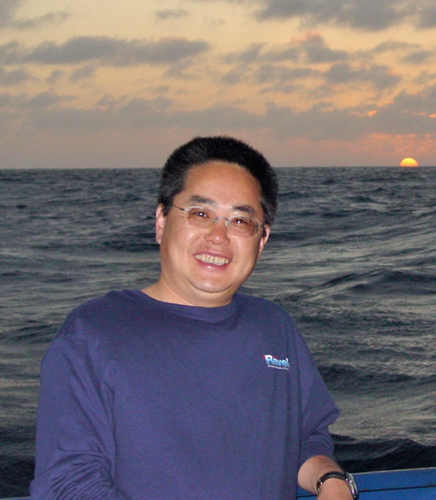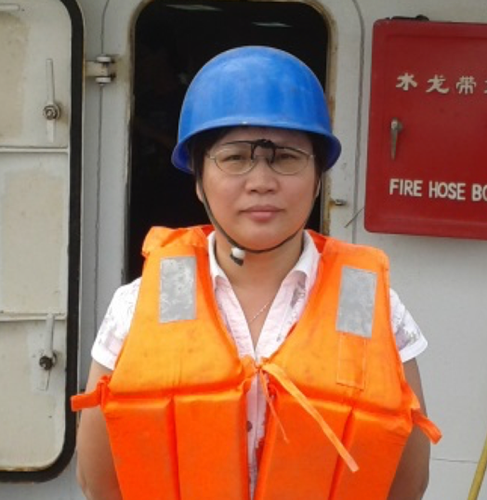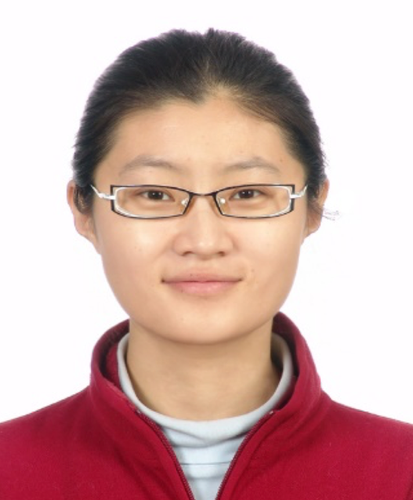Marine Ecosystem Modeling and Forecasting System in the China Seas and Northwestern Pacific (MEMFiS)
Summary of the project
China´s coastal regions are under increasing pressure from both climate change and intensive human activity. The ecology of the coastal regions are particularly threatened by eutrophication, red tides and hypoxia events, etc. This raises the question of whether, and to what extent, ecological changes in coastal regions can be predicted, in order to preserve and retain their function and economic value.
Focusing on the ecology of the Bohai, Yellow, East and South China Seas, and the Northwestern Pacific, the MEMFis project aims to develop an integrated modelling and forecasting framework, using high-resolution physical-ecosystem models and data from multiple sources. By investigating ecosystem variability at different temporal and spatial scales, several key scientific questions will be tackled. Marine ecosystem variability will be addressed at the interface of different systems, parameterizations optimized for biogeochemical processes in different regions, data assimilation and ecosystem forecasting using multiple observations not only from moorings, buoys and ships, but also from bio-Argo, gliders and high-resolution satellite imagery.
More than 15 research institutes are involved in MEMFiS including the Second Institute of Oceanography, Tianjin University, the South China Sea Institute of Oceanology, and the National Marine Environmental Forecasting Center.
Area of study

Figure: The project includes four regional and forecasting models: the Pacific model, the Bohai-Yellow Sea model, the Yellow-East China Sea model, and the South China Sea model. These are all based on the coupled ROMS-CoSiNE model but with regional optimized parameters. Data from cruise surveys, gliders, bio-Argo and moorings will be incorporated into the models.
Timetable
July 2016 - December 2020
Project Updates
Major achievements
- The project investigated the cross-shelf water exchange near surface in the East China Sea, and the variability of seasonal intrusion of Kuroshio to the East China Sea. The relative position between Kuroshio Current and shelf break can impact the location of Kuroshio intrusion in winter, spring and summer via beta effect. The relevant results are published in “Yang, D., Yin, B., Chai, F., Feng, X., Xue, H., Gao, G., & Yu, F. (2018). The onshore intrusion of Kuroshio subsurface water from February to July and a mechanism for the intrusion variation. Progress in Oceanography, 167, 97-115.”
- The high-resolution coupled physical-biological model, namely ROMS-CoSiNE, successfully simulated the hypoxia off the Changjiang Estuary in 2006. The nutrients during hypoxia was transported via the discharge of Changjiang River and Kuroshio Current. The usage of dissolved oxygen in the sediment largely determined the scale of hypoxia. The relevant results are published in “Zhou, F., Chai, F., Huang, D., Xue, H., Chen, J., Xiu, P., ... & Wang, K. (2017). Investigation of hypoxia off the Changjiang Estuary using a coupled model of ROMS-CoSiNE. Progress in Oceanography, 159, 237-254.”
- Based on the survey data, the seasonal and spatial characteristics of Trichodesmium in East China Sea and southern Yellow Sea have been analyzed. The N2 fixation rates of Trichodesmium and its relationship with physicochemical properties were studied, which provided a nice case for Marine Environmental Forecast. The relevant results are published in “Jiang, Z., Li, H., Zhai, H., Zhou, F., Chen, Q., Chen, J., ... & Yan, X. (2018). Seasonal and spatial changes in Trichodesmium associated with physicochemical properties in East China Sea and southern Yellow Sea. Journal of Geophysical Research: Biogeosciences, 123(2), 509-530.”
- Based on multiple data sources, strong fronts due to Kuroshio intrusion and interactions with the South China Sea water were found to be associated with intense upwelling, supplying high nutrients from the subsurface and increasing phytoplankton production along the frontal region. The relevant results are published in “Guo, L., Xiu, P., Chai, F., Xue, H., Wang, D., & Sun, J. (2017). Enhanced chlorophyll concentrations induced by Kuroshio intrusion fronts in the northern South China Sea. Geophysical Research Letters, 44(22).”
- Using observational data and modelling results, we found that both cyclonic eddies and wind-induced mixing affect phytoplankton variability in the northern South China Sea, but the former is the dominant factor regulating the interannual variability of chlorophyll during La Nina years, while the latter becomes the dominant one during El Nino years. The relevant results are published in “Xiu, P., Dai, M., Chai, F., Zhou, K., Zeng, L., & Du, C. (2019). On contributions by wind‐induced mixing and eddy pumping to interannual chlorophyll variability during different ENSO phases in the northern South China Sea. Limnology and Oceanography, 64(2), 503-514.”
- Based on a coupled physical-biogeochemical model of the Yellow and East China Seas, the influence of biological activity on the seasonal variation of the air–sea CO2 flux is evaluated.The comparison reveals that biological activity results in a much stronger seasonal variation of surface dissolved inorganic carbon (DIC) and, hence, the ratio of total alkalinity to DIC in the northern parts of the Yellow and East China Seas. The relevant results are published in “Luo, X., Wei, H., Zhao, L., & Lu, Y. (2018). A Model Evaluation of Biological Effects on Seasonal Variation of Air–Sea CO2 Flux in the Yellow and East China Seas. Atmosphere-Ocean, 56(1), 12-27.”
- Based on the high-resolution physical-biological model results, the data assimilation experiment was carried out by using the EnOI and EnKF methods. The relevant results are published in “Ji, X., Kwon, K. M., Choi, B. J., Liu, G., Park, K. S., Wang, H., ... & Zhu, X. (2017). Assimilating OSTIA SST into regional modeling systems for the Yellow Sea using ensemble methods. Acta Oceanologica Sinica, 36(3), 37-51.”
- Based on the coupled models built by different subprojects, there are two high-resolution operational forecasting systems running, providing multiple forecasting products including concentrations of nutrients, chlorophyll, and dissolved oxygen etc. These two operational systems are currently running smoothly and are able to achieve the goal of 72-hour forecasting of the project. They will also be further improved with more data obtained during the next a few years.
Capacity building activities
- Hold the International Symposium on “Harmful Algal Blooms and Hypoxia in a Changing Ocean” during May 25-26th, 2018 in Hangzhou, China.
- Hold the “4th Global Ocean Acidification Observing Network (GOA-ON) International Workshop” during April 14-17th, 2019 in Hangzhou, China.
- The Biogeochemical Argo (BGC-Argo) observation network is set up in the Northwest Pacific, and 8 BGC-Argo floats have been deployed in the Northwest Pacific.
Upcoming activities
- Another 8 BGC-Argo floats will be deployed in the Northwest Pacific in the late of 2019.
List of 2018/19 publications
- Ding, M., Lin, P., Liu, H., & Chai, F. (2018). Increased Eddy Activity in the Northeastern Pacific during 1993–2011. Journal of Climate, 31(1), 387-399.
- Ji, Q., Shao, W., Sheng, Y., Yuan, X., Sun, J., Zhou, W., & Zuo, J. (2018). A Promising Method of Typhoon Wave Retrieval from Gaofen-3 Synthetic Aperture Radar Image in VV-Polarization. Sensors, 18(7), 1-14.
- Jiang, Z., Li, H., Zhai, H., Zhou, F., Chen, Q., Chen, J., & Yan, X. (2018). Seasonal and spatial changes in Trichodesmium associated with physicochemical properties in East China Sea and southern Yellow Sea. Journal of Geophysical Research: Biogeosciences, 123(2), 509-530.
- Lu, C., Fu, C., & Yang, H. (2018). Time-fractional generalized Boussinesq equation for Rossby solitary waves with dissipation effect in stratified fluid and conservation laws as well as exact solutions. Applied Mathematics and Computation, 327, 104-116.
- Luo, X., Wei, H., Zhao, L., & Lu, Y. (2018). A Model Evaluation of Biological Effects on Seasonal Variation of Air–Sea CO2 Flux in the Yellow and East China Seas. Atmosphere-Ocean, 56(1), 12-27.
- Qian, S., Wei, H., Xiao, J. G., & Nie, H. (2018). Impacts of the Kuroshio intrusion on the two eddies in the northern South China Sea in late spring 2016. Ocean Dynamics, 1-15.
- Xing, C., Zhao, Q., Hu, Z., & Liu, Y. (2017). Direct Observations and Modeling of Summertime Coastal Circulation Patterns in the Western Bohai Sea. Journal of Coastal Research, 34(2), 373-382.
- Xiu, P., Chai, F., Curchitser, E. N., & Castruccio, F. S. (2018). Future changes in coastal upwelling ecosystems with global warming: The case of the California Current System. Scientific reports, 8(1), 2866, 1-9.
- Yang, D., Yin, B., Chai, F., Feng, X., Xue, H., Gao, G., & Yu, F. (2018). The onshore intrusion of Kuroshio subsurface water from February to July and a mechanism for the intrusion variation. Progress in Oceanography, 167, 97-115.
- Du, Y., Song, W., He, Q., Huang, D., Liotta, A., & Su, C. (2019). Deep learning with multi-scale feature fusion in remote sensing for automatic oceanic eddy detection. Information Fusion, 49, 89-99.
- Xiu, P., Dai, M., Chai, F., Zhou, K., Zeng, L., & Du, C. (2019). On contributions by wind‐induced mixing and eddy pumping to interannual chlorophyll variability during different ENSO phases in the northern South China Sea. Limnology and Oceanography, 64(2), 503-514.
- Xuan, J., Su, J., Wang, H., Huang, D., Ding, R., Zhou, F., ... & Pohlmann, T. (2019). Improving low-resolution models via parameterisation of the effect of submesoscale vertical advection on temperature: A case study in the East China Sea. Ocean Modelling, 136, 51-65.





